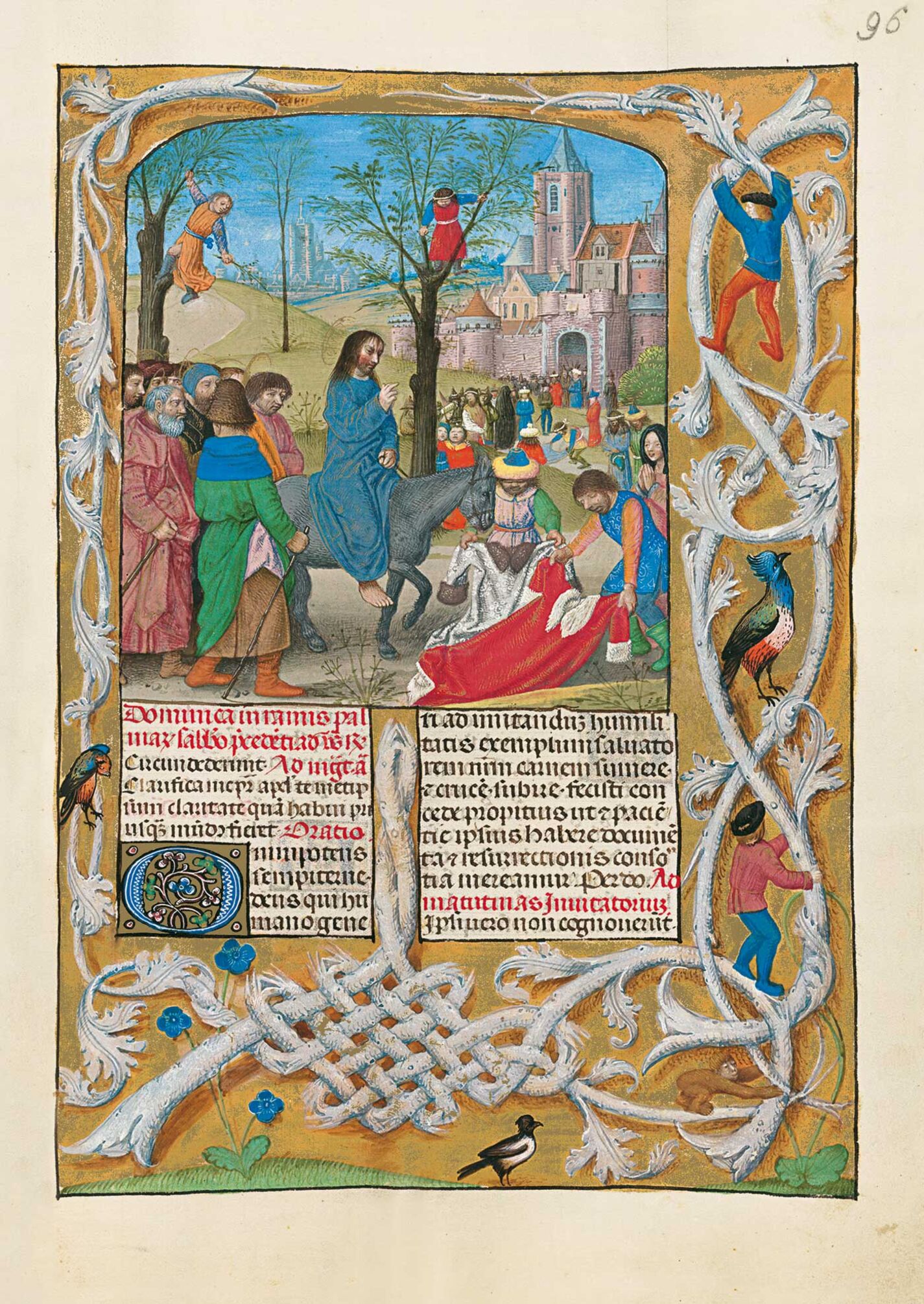This painting in the temporale, yet another work by the Master of the Dresden Prayer Book, shows the apostles on the far left – amongst whom St Peter can be identified by his white hair and beard – following a barefooted Jesus Christ in a plain blue tunic. Christ’s right hand is raised in blessing and his left holds the reins of the donkey he is riding. Opposite him, two men lay their lavish, long robes on the ground in his honour and a woman joins her hands to worship the Lord. Further back are two children each up a tree. In the background are another man laying his tunic on the ground and several other figures including some Jews watching and commenting upon the scene in front of the gate of a walled city. And finally, in a bluish tone due to the distance, stands another large, fortified city.
As in the formula used since the Codex Purpureus Rossanensis (Rossano, Museo dell’Arcivescovado, f. 1v), written in Constantinople or Antioch in the third quarter of the 6th century, the disciples acting like a committee and the inhabitants of Jerusalem are moving in opposite directions, all converging on the figure of the Lord. This scene is told in both the synoptic Gospels (Matt. 21: 1-11; Mk. 11: 1-10 and Lk. 19: 29-40) and in St John’s (Jn. 12: 12-19). However, the fact that the Lord rides a donkey suggests its source was St Matthew and St John, both of whom gave literal interpretations of a messianic prophecy by Zachariah (Zach. 9:9). The celebrations by the inhabitants of Jerusalem are taken from the Acts of Pilate or the Apocryphal Gospel of Nicodemus where it says that “the children of the Jews clamoured with branches in their hands whilst others laid their garments on the ground”.
The scene of Jesus’ entrance into Jerusalem was originally due to the assimilation by Christian art of an imperial iconography stemming from the Hellenistic and Roman ritual of the sovereign visiting a square in his empire or a conquered city. The way Jesus rides astride in the
Isabella Breviary has been linked since the onset of this iconography with the Roman formula. Casting garments upon the path taken by the Lord was a gesture to honour the anointed king (Kgs. 2 9: 13). The earliest portrayals of Christ’s entrance into Jerusalem date from the 4th century and are influenced not only by the liturgy of Palm Sunday but also by the symbolic meaning of the city of Jerusalem. This city was not only the political and ideological capital of the Jews – the hub of the great feasts held in Solomon’s Temple – and the setting for Christ’s Passion, but also the eternal city, the Heavenly Jerusalem of Christianity. The oldest representations in the Hellenistic world emphasised an eschatological, symbolic meaning: the Lord’s triumphant entrance into the heavenly city represented his victory over death. Like the image in one of the detailed panels of the Passion in the altarpiece in the church of the Schottenstift monastery, Vienna, made by a Viennese master prior to 1469, the happening is shifted to a fortified, medieval city with walls, towers and a moat.
The extremely original border features acanthus branches painted as white cameos ending in hands. The stems interweave at the bottom in a way reminiscent of the old Carolingian decoration from the school of Tours, stemming from French and Insular models. Perched amongst the plant forms are two birds, two clambering men and a small monkey. On the grassy ground are a magpie and flowering plants.
